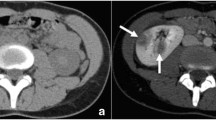Abstract
A calyx which fails completely to opacify on excretory urography (phantom calyx) is often the harbinger of serious underlying renal disease. Causes of a phantom calyx include tuberculosis, tumor, calculus, ischemia, trauma, and congenital anomaly. The pathologic basis for the radiographic findings in each of these entities is described and an overall approach to diagnosis is set forth.
Similar content being viewed by others
References
Kollins SA, Hartman GW, Carr DT, Segura JW, Hattery RR: Roentgenographic findings in urinary tract tuberculosis: a ten year review.Am J Roentgenol 121:487–499, 1974
Gay R: Focal exclusions in renal tuberculosis.Acta Radiol 32:129–144, 1949
Barrie HJ, Kerr WK, Gale GL: The incidence and pathogenesis of tuberculous strictures of the renal pelvis.J Urol 98:584–589, 1967
Hartman GW, Segura JW, Hattery RR: Infectious diseases of the genitourinary tract. In DM Witten, GH Myers, DC Utz (eds): Emmett’s Clinical Urography: An Atlas and Textbook of Roentgenologic Diagnosis, Philadelphia: W.B. Saunders, 1977, pp 809–949
Silver TM, Kass EJ, Thornbury JR, Konnak JW, Wolfman MG: The radiological spectrum of acute pyelonephritis in adults and adolescents.Radiology 118:65–71, 1976
Murchinson RJ, Nicholson TC: Absent collecting system sign.Urology 10:343, 1977
Levin DC, Gordon D, Kikhabwala M, Becker JA: Reticular neovascularity in malignant and inflammatory renal masses.Radiology 120:61–68, 1976
Cope JR, Roylance J, Gordon IRS: The radiological features of Wilm’s tumour.Clin Radiol 23 (3):331–339, 1972
Heitzman ER, Perchik L: Radiographic features of renal infarction: review of 13 cases.Radiology 76:39–46, 1961
Paul GJ, Stephenson TF: The cortical rim sign in renal infarction.Radiology 122:338, 1977
Griscom NT, Kroeker MA: Visualization of individual papillary ducts (ducts by Bellini) by excretory urography in childhood hydronephrosis.Radiology 106:385–389, 1973
Ambos MA, Bosniak MA: Tomography of the kidney bed as an aid in differentiating renal pelvic tumor and stone.Am J Roentgenol 125:331–336, 1975
Pollack HM, Arger PH, Goldberg BB, Mulholland SG: Ultrasonic detection of nonopaque renal calculi.Radiology 127:233–237, 1978
Webb JAW, Fry IK, Charlton CAC: An anomalous calyx in the mid-kidney: an anatomical variant.Br J Radiol 48:674–677, 1975
Friedland GW, Filly RA: Appearing and disappearing calyces.Pediatr Radiol 1 (4):237–240, 1973
Dure’-Smith P: In RE Miller, J Skucas (eds):Radiographic Contrast Agents. Baltimore: University Park Press, 1977, p 297
Author information
Authors and Affiliations
Rights and permissions
About this article
Cite this article
Brennan, R.E., Pollack, H.M. Nonvisualized (“phantom”) renal calyx: Causes and radiological approach to diagnosis. Urol Radiol 1, 17–23 (1980). https://doi.org/10.1007/BF02926595
Issue Date:
DOI: https://doi.org/10.1007/BF02926595




